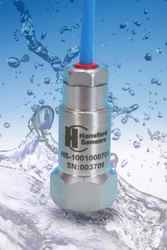
Posted to News on 28th Aug 2013, 17:55
Vibration monitoring in marine engine management
Challenges such as rising fuel prices and more rigorous emissions regulations have posed problems for marine operators in recent years. In the face of such challenges, a proactive vibration monitoring programme is one of the most effective options that can be applied, says Chris Hansford, Managing Director, Hansford Sensors.

In an increasingly competitive global market, vessel owners and managers are under growing pressure both to protect operating margins through cost efficiencies, and to comply with ever tougher environmental legislation. For example, many marine operators find that running and maintaining engines alone represents a significant proportion of overall operating costs. With rising fuel prices and more rigorous emissions regulations it seems certain that these costs will continue to grow. And there are further complications; for example, fuel quality, in terms of dirt content and water contamination, has been getting worse over recent years with the introduction of lower sulphur fuels and bio diesel blends, which have put engines at greater risk. On the plus side, recent advances in engine system design have proven to be particularly effective, and now mean that engines are capable not only of low emissions but also of increased economy and better power and performance profiles. However, with tolerances tight and pressures running high, engines have become increasingly susceptible to wear and corrosion even from very low levels of contamination. Engine systems therefore require careful management, and that can be effectively achieved by using powerful preventative maintenance tools such as vibration monitoring.
Vibration monitoring is a key tool used by marine engineers to manage the availability and maintenance of a wide range of equipment with rotating shafts, including pumps, motors, fans and gearboxes, as well as engine systems. A proactive condition monitoring programme provides informative and proactive data that removes the need for invasive maintenance. In the marine environment vibration monitoring is one of the most effective options that can be applied.
Safe operation of ships in service
Marine classification rules dictate the regular performance of an intrusive visual inspection to provide assurance of the physical condition and integrity of all components. This process ensures continued safe operation of ships in service, which is a major undertaking, especially for the operators and engineers of larger vessels. Logistically and economically, the whole process is a challenge; even when plans are carefully drawn for spare parts to be made available, the inspection process can still take weeks rather than days in dry dock. For many vessels, a couple of weeks' downtime is simply not an economically viable option.
The alternative, of course, is equally unappealing. No operator wants to garner the bad publicity that can be drawn by severe failures, whether they affect a merchant vessel or a cruise ship. If a container ship runs into problems and needs to make an unscheduled docking, the resulting difficulties and potential fines can make an extended period of scheduled downtime look positively appealing. Similarly, the malfunction of ventilation fans in hotels on cruise ships can seriously damage the credibility of the cruise line and will almost certainly be more expensive and awkward to put right than implementing preventative monitoring measures.
Concern over all these potential catastrophes explains why today's designers and engineers have succeeded in developing a range of tools and practices to prevent vibration and its consequences. There has been a marked growth in the use of simple alignment tools and automatic lubricators that can be applied during system construction. In addition, components themselves are continually being refined and upgraded to offer greater resistance to vibration. Certainly, a good installation and management of rotating equipment will save a lot of trouble, but because vibration can never be entirely banished from rotating machinery we need to apply vibration monitoring technology. There has been much development in vibration monitoring technology to help engineers minimise failure. In particular, vibration sensors increasingly offer exceptional reliability packaged in a variety of resilient enclosures to enable their use within a wide range of applications.
By applying non-invasive vibration analysis to measure factors such as bearing surface condition, along with associated techniques such as ultrasonic inspection to check for potential cracks in the bearings, vibration sensor technology will help keep bearings working 24 hours per day, a vital service for shipping where round-the-clock performance is often a pre-requisite. This explains why, where marine machinery is concerned - especially propulsion and manoeuvring systems, engines and turbochargers - vibration monitoring is becoming a more widely adopted facet of condition monitoring. Alongside other powerful tools such as oil monitoring and thermal imaging, vibration monitoring is protecting profits and enhancing performance.
Special conditions for on-board monitoring
The sensor technology used to measure levels of vibration, together with the instruments and software for gathering and analysing data, is typically easy to install and use. However, it is not without its challenges. For example, ships do not have an earth facility, so special conditions have to be applied to the installation of on-board monitoring equipment. Similarly, it is important to consider the areas of classification; on an oil tanker, for instance, the cargo pumps may require intrinsically safe accelerometers connected via a barrier to the safe areas.
Sensors and accelerometers for vibration monitoring offered by companies such as Hansford Sensors can operate over a wide temperature range, measuring both high and low frequencies with low hysteresis characteristics and excellent levels of accuracy. When it comes to the often aggressive environments presented by life at sea, stainless steel sensor housings enable these devices to operate for long periods without failure by preventing contaminants such as moisture, dust and oil.
The operating principle of an accelerometer is thus: accelerative force causes a mass within the sensor to compress the piezoelectric crystal to which it is bonded. The compression of the piezoelectric crystal produces an electrical signal that is proportional to the level of force applied. Inbuilt electronics within the sensor create a useable output that can be used by a data acquisition or control system by amplifying and conditioning the electrical signal produced by the crystal. By mounting accelerometers on machinery, this valuable data can be gathered in a number of ways, for example, using hand-held data collectors. For continuous monitoring, data can be routed via switch boxes to a centralised or higher level system.
There are two main categories: AC accelerometers, which are used with a data collector for monitoring the condition of higher-value assets such as wind turbines, and 4-20mA accelerometers, which are used with a PLC to measure lower-value assets such as fans and pumps. Both are capable of detecting imbalance, bearing condition and misalignment but AC accelerometers can also identify cavitation, looseness, gear defects and belt problems.
In choosing an appropriate accelerometer from the many options now available, engineers need to consider the vibration level and frequency range that is to be measured, as well as environmental conditions, such as the temperature and whether there are any corrosive chemicals present. A series of further considerations follow on from there; for instance, is the atmosphere combustible? Are there weight constraints? However, consultation with a company that has experience in a wide range of sectors can swiftly enable the right decisions to be made. One such company, Hansford Sensors, offers AC and 4-20mA versions of the HS-100 and HS-420 Series that are intrinsically safe, being ATEX and IEC Ex certified. These industrial vibration sensors can be used to monitor vibration levels on pumps, motors, fans and all other types of rotating machinery found in marine applications.
Remote monitoring systems
To maximise the performance of this compact but powerful piece of technology, an accelerometer must be correctly installed. A poorly fitted or maintained accelerometer will not offer the precision or longevity of which it is capable. In the marine sector, where operating conditions are subject to a wide range of variables, the need to maximise the effectiveness of these devices is great. An illustration of this is that readings taken in port will almost certainly be different from those taken when the vessel is at sea, and heavy weather will only amplify any such differences. It is in everyone's interest to specify high-quality accelerometers and apply the best practice in managing their performance, particularly as health and safety requirements in all industries continue to be refined. The use of remote monitoring systems enables both performance and safety levels to be maximised, as engineers are no longer required to come into close contact with potentially hazardous equipment.
To correctly install an accelerometer, engineers should mount the device directly onto the machine on a flat, smooth, unpainted surface that is larger than the base of the accelerometer. The installer should ensure that the area is free from grease and oil and as close as possible to the source of vibration. By following these guidelines, you will have already supported your accelerometer, and thus your maintenance regime, by enabling the device to give the most accurate measurements of vibration levels.
Once data has been collected in the most appropriate and efficient manner, machine reliability data must be analysed and interpreted, either by on-board engineers or by a remote monitoring centre. This will build a picture of machine condition and help to create a future maintenance schedule. With an efficient vibration monitoring system now in place, marine engineers find they have progressed to a new level of efficiency. With systems well protected by accelerometers and associated technology to monitor vibration, engineers can move on to identify areas for further improvement in terms of machine performance, energy efficiency or output.
With the continuing advances in monitoring techniques and options, vibration monitoring represents an increasingly economically viable option of protecting profits for all ship operators in the marine sector. Just as importantly, the reduced need for maintenance leaves engineers free to focus on more crucial tasks, while the reduced failure and maintenance required minimises the environmental impact and enables significant improvements in profitability to be realised.
For more information on the extensive range of Hansford Sensors products, including vibration monitoring equipment, please visit www.hansfordsensors.com.
Want the latest machine building news straight to your inbox? Become a MachineBuilding member for free today >>
Artisan, Hillbottom Road
Sands Industrial Estate
HP12 4HJ
UNITED KINGDOM
+44 (0)845 680 1957















